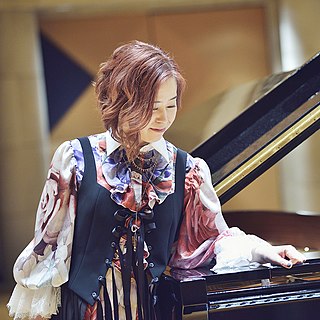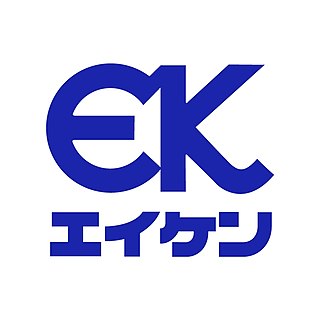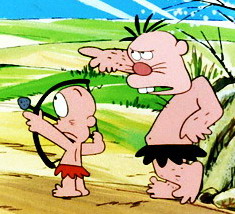Related Research Articles

Anime is hand-drawn and computer-generated animation originating from Japan. Outside Japan and in English, anime refers specifically to animation produced in Japan. However, in Japan and Japanese, anime describes all animated works, regardless of style or origin. Many works of animation with a similar style to Japanese animation are also produced outside Japan. Video games sometimes also feature themes and art styles that are sometimes labelled as anime.

Kimba the White Lion, known in Japan as Jungle Emperor, is a Japanese shōnen manga series written and illustrated by Osamu Tezuka which was serialized in the Manga Shōnen magazine from November 1950 to April 1954. An anime based on the manga was created by Mushi Production and was broadcast on Fuji Television from 1965 to 1967. It was the first color animated television series created in Japan. It began airing in North America from 1966. The later series was produced by Tezuka Productions.

Yuki Kajiura is a Japanese composer, arranger and music producer. She has provided the music for several popular anime series, such as Sword Art Online, Puella Magi Madoka Magica, Fate/Zero, The Garden of Sinners, Pandora Hearts and Demon Slayer: Kimetsu no Yaiba.

Mushi Production or Mushi Pro for short, is a Japanese animation studio headquartered in Fujimidai, Nerima, Tokyo, Japan. It previously had a headquarters elsewhere in Nerima.

Tatsuo Yoshida was a Japanese manga artist, illustrator, as well as anime pioneer who founded the animation studio Tatsunoko Production as a businessman and the original author of many anime works.
Fumiya Satō is a Japanese manga artist. She is best known for the manga series The Kindaichi Case Files and Detective School Q. In 1995, she received the Kodansha Manga Award for her work on The Kindaichi Case Files.
Rachel Thorn is a cultural anthropologist and a faculty member at the Kyoto Seika University's Faculty of Global Culture in Japan.
Takuya Igarashi is a Japanese freelance storyboard artist and director who has worked for Toei Animation and currently Bones. He has also sometimes used the alias Jūgo Kazayama.
Bernie Baum was a songwriter who worked extensively with Elvis Presley. He grew up in New York City and later worked with Harvey Zimmerman and Florence Kaye. The majority of their songs were used in Presley's musicals. He and his two collaborators also wrote a theme music package for the NBC Weekend radio service called "Monitor" in 1965. Their work was also credited in the American version of Osamu Tezuka's anime Kimba the White Lion (1965). He had a #1 Hit with his song "Music! Music! Music!", Teresa Brewer's B side recording which unexpectedly took off, selling over a million copies and becoming Teresa's signature song with his other works included:

Obake no Q-Tarō is a Japanese manga series by Fujiko Fujio about the titular obake, Q-Taro, who lives with the Ōhara family. Q-Tarō, also known as "Q-chan" or "Oba-Q", is a mischief-maker who likes to fly around scaring people and stealing food, though he is deathly afraid of dogs.
Tsuneo Kobayashi was a Japanese anime director affiliated with Pierrot. He was best known as the director of critically acclaimed anime series The Twelve Kingdoms.
Shun'ichi Yukimuro is a Japanese screenwriter for anime television series. Yukimuro has had a career spanning four decades and written over 3,000 anime television series scenarios, including episodes of many classic series produced by the Toei Animation studio.
Gisaburō Sugii is a Japanese anime director and Nihonga artist. He is best known for his work as director of the Touch series, the movie adaptation of the Arashi no Yoru ni children's book series, and the movie Night on the Galactic Railroad. He is a member of the Directors Guild of Japan and the Japanese Animation Creators Association.
Keiichi Sato is a Japanese animation director, mecha and character designer born in Kagawa Prefecture.

Eiken Co., Ltd. is a Japanese anime studio in Arakawa, Tokyo, Japan. The company was formerly known as Television Corporation of Japan Co., Ltd. or TCJ before changing its name in 1969 to establish Eiken. It is a wholly owned subsidiary of Asatsu-DK.
Ikuto Yamashita is a Japanese manga artist and designer.
Taro Iwashiro is a Japanese composer.
Events in 1965 in Japanese television.

Giatrus is a Japanese manga written and illustrated by Shunji Sonoyama. It spawned two other manga, two anime television series, a television drama, and an anime film. The first TV series mark the debut of Joe Hisaishi, composer of My Neighbor Totoro and Spirited Away. The official English title is Gon, The Stone-Age Boy.
Takayuki Hattori is a Japanese film, television, video game and non-soundtrack music composer, arranger and conductor. He is the son of the composer Katsuhisa Hattori and grandson of composer Ryōichi Hattori. He has won three Japan Academy Prize awards in the category Outstanding Achievement in Music and was the music director of the Japan Pavilion at the Expo 2010. In recent years, Hattori has worked with popular supergroup JAM Project, serving as orchestral arranger and conductor on two of their albums, Victoria Cross and THUMB RISE AGAIN, as well as in their live concerts promoting said albums.
References
- ↑ Hodgkins, Crystalyn (17 August 2012). "Tezuka's New Treasure Island Special to Screen in Los Angeles". Anime News Network . Retrieved 2 November 2021.